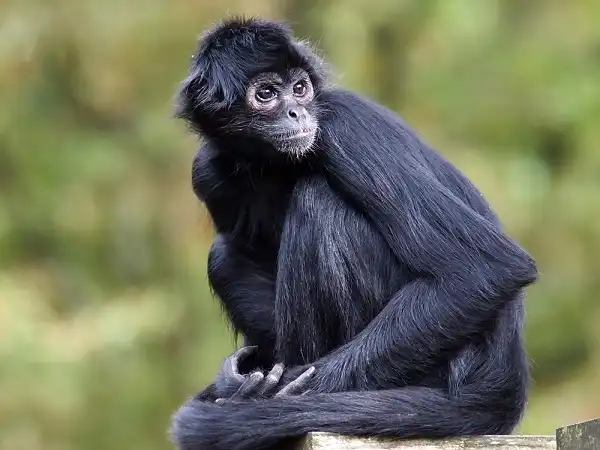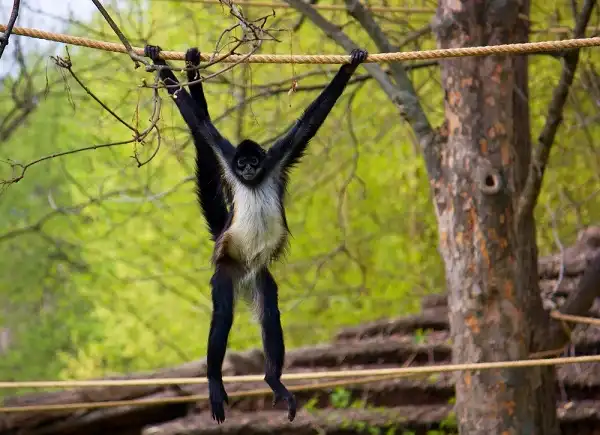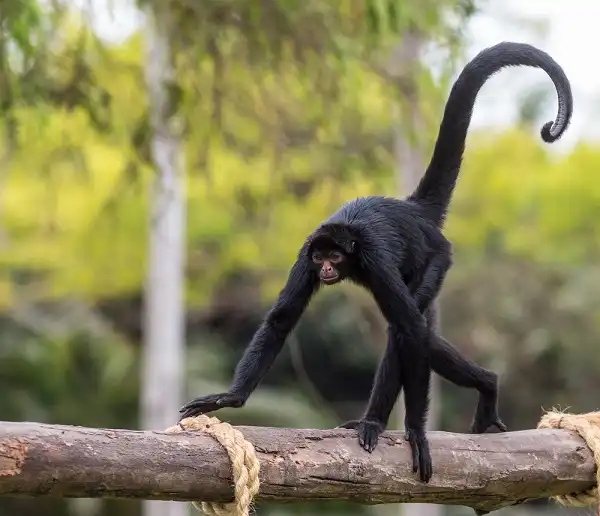Have you ever heard of a spider monkey? These primates are captivating animals, remarkable for their intelligence and ability to adapt to different habitats. Their impressive agility and graceful movements make them especially interesting to observe. Spider monkeys play an important role in their ecosystems, helping to disperse seeds from the food they eat throughout the forest – so we can thank them for some of the lush natural beauty we see today! In this blog post, we will explore the fascinating habits of spider monkeys, discuss their importance in global conservation efforts, and discover how changes in human behavior can help protect these precious creatures from extinction.

Spider Monkey Description
Spider monkeys are a species of New World monkeys found in tropical forests across Central and South America. The most distinguishing feature of these primates is their long, thin arms and legs that give them an arachnid-like appearance. They have brown or black fur, which can be either short or long depending on the species. On the head of a spider monkey, there are two tufts of hair that resemble horns and give them a unique look. They also have white eye rings and short snouts with large nostrils that enable them to pick up scents from far away. In addition, they have opposable thumbs on both hands and feet for grasping branches while swinging through the trees.
Spider Monkey Habitat
Spider monkeys live in the tropical forests of Central and South America. They prefer to inhabit moist forests with a wide variety of trees, as well as plenty of fruit-bearing plants to satisfy their dietary needs. These primates can also be found living near rivers and lakes as they are excellent swimmers and often search for food in the water. Spider monkeys are most comfortable living in the higher canopy area of forests, which provides them with enough space to move around while still keeping hidden from predators. In addition, they build nests high up in the trees out of branches and leaves, providing not only shelter but also safety from ground-dwelling predators. Unfortunately, due to growing human activity such as deforestation and illegal pet trade, spider monkey habitats are becoming increasingly smaller and fragmented – leading to a major decline in population numbers throughout Central and South America. In order to protect these precious creatures from extinction, conservation efforts need to focus on preserving their natural habitats by creating protected areas around vulnerable environments such as rainforests or mangrove swamps. Additionally, laws that prevent hunting or poaching of these animals must be strictly enforced so that they can continue to thrive for generations to come.

Spider Monkey Diet
Spider monkeys primarily feed on fruits, nuts, leaves, flowers, and gums from trees in their habitats. They have an excellent sense of smell that allows them to track down sources of food within their area. They are also known to occasionally eat insects and even bird eggs when they’re available. In addition, spider monkeys have been observed eating clay on occasion as a means to supplement their diet with important minerals like sodium and calcium. The primates also spend time foraging the forest floor for grubs and other small creatures to supplement their diets during times of scarce fruit availability. Spider monkeys play an essential role in maintaining healthy ecosystems throughout Central and South America by helping to disperse seeds from the food they eat throughout the forest – providing sustenance for other animals as well as aiding in regeneration efforts for plants over time. This helps ensure a balanced ecosystem in which different species can thrive together.
Spider Monkey Size
Spider monkeys are medium-sized primates that range in size depending on their species. The smallest species, the pygmy marmoset, usually reaches only around 6 inches in height and weighs about 4 ounces. On the other end of the spectrum, howler monkeys can grow to lengths of up to 3 feet and weights of up to 20 lbs. In general, spider monkeys have long arms, short legs, and a prehensile tail that is used for holding onto branches while they swing from tree to tree. In addition to their body size, spider monkey faces vary significantly based on species. For example, some spider monkeys have white markings around their eyes and noses while others are completely black except for a few patches of fur near the cheeks or top of the head. Spider monkeys also possess opposable thumbs which they use to grip branches and manipulate objects such as food or tools.
Spider Monkey Lifespan
Spider monkeys typically have a lifespan of around 25 years in the wild, with some species living up to 30-40 years. In captivity, spider monkeys can live even longer as they are provided with more consistent sources of food and medical care. The average lifespan may vary slightly depending on their habitat and the particular species of spider monkey. For example, howler monkeys tend to live longer than other species due to their greater body size and increased protection from predators. Additionally, spider monkeys living in areas where there is greater food availability may also live longer as they are able to consume a more nutritious diet. In addition to their longevity, spider monkeys can reproduce and give birth throughout their life cycle. Females reach sexual maturity at an early age and can give birth up to four times over the course of their lifetime – producing 2-3 offspring per pregnancy. However, mortality rates among infants remain high due to predation or disease – meaning that not all young spiders will successfully reach adulthood.

Spider Monkey Behavior
Spider monkeys are highly social primates and demonstrate a diverse range of behaviors in their daily lives. They form close-knit groups of up to 10 individuals, usually consisting of one male, several females, and their offspring. Males typically act as the dominant members of these troops and are responsible for leading them to food sources or new areas. Within each group, spider monkeys often engage in playful activities such as chasing, wrestling, and grooming one another. This helps create strong social bonds between members while also providing opportunities for young individuals to learn important skills that will help them survive in the wild. In addition to their playfulness, spider monkeys also use various vocalizations to communicate within the troop – from alarm calls warning about predators to low-pitched murmurs indicating contentment or relaxation. These primates can also be quite territorial and are known to display aggressive behavior when confronted by other animal species encroaching on their space.
Spider Monkey Speed
Spider monkeys are quite agile primates, capable of moving quickly through the trees with relative ease. They are adept climbers and use their long arms and legs to propel themselves forward with amazing speed and agility. Spider monkeys have been recorded traveling up to 20 feet (6 meters) per second when jumping between branches; they can also move rapidly within a single tree, leaping from one branch to another in seconds! In addition to their impressive agility, spider monkeys can also sustain high speeds for extended periods of time; they may travel as far as two miles (3 kilometers) in a single day at a relatively quick pace. This allows them to cover large areas searching for food sources or avoiding predators.
Spider Monkey Hunting
Spider monkeys are known for their impressive hunting skills, which enable them to catch prey items such as fruits, nuts, insects, and small vertebrates. These primates use a range of strategies when hunting for food, ranging from acrobatic leaps to stealthy stalking. When using acrobatic leaps, spider monkeys will often jump from branch to branch in search of prey. This strategy allows them to spot potential targets quickly and effectively while also avoiding any potential predators on the ground. In addition to leaping between branches, spider monkeys are also adept at stalking their prey by remaining still and silent until they are close enough to capture the animal or insect. This tactic requires patience but is highly effective in allowing these primates to find those elusive snacks! Spider monkeys are also skilled at identifying edible fruits and nuts due to their acute sense of smell and sharp vision. They can distinguish ripe fruit from unripe ones or detect nut-bearing trees from a distance – allowing them to plan ahead and acquire the necessary nourishment for their troops.

Conclusion
Spider monkeys are incredible primates with amazing physical abilities and hunting skills that help them survive in the wild. They possess impressive speed and agility, allowing them to move quickly between branches while avoiding predators. Additionally, spider monkeys demonstrate remarkable skill when it comes to locating food sources – using a range of techniques such as acrobatic leaps and stealthy stalking. It is essential that we continue conservation efforts for these fascinating primates so that they can have a long future in their natural habitats! By protecting their habitats, monitoring population sizes, and reducing threats from human activities, we can ensure that these incredible animals remain safe and healthy for generations to come.
Frequently Asked Question

